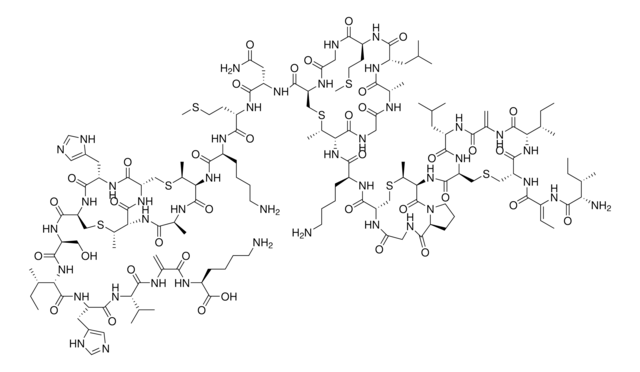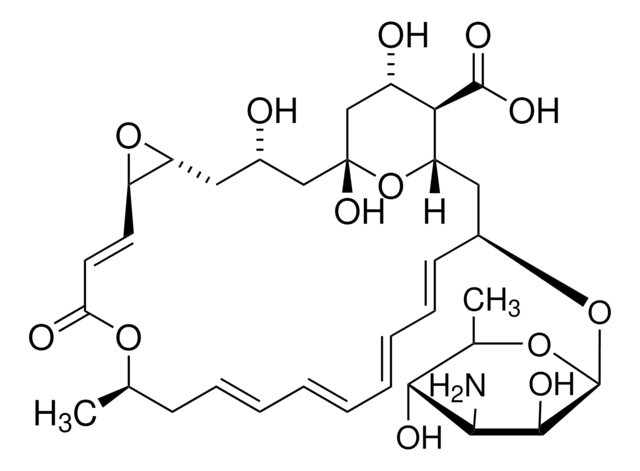N5764
Nisin from Lactococcus lactis
potency: ≥900 IU/mg
Synonym(s):
Nisin A
About This Item
Recommended Products
form
powder
Quality Level
potency
≥900 IU/mg
antibiotic activity spectrum
Gram-negative bacteria
Gram-positive bacteria
mode of action
cell membrane | interferes
storage temp.
2-8°C
SMILES string
[H]N[C@@H]([C@@H](C)CC)C(=O)N\C(=C\C)C(=O)N[C@H]1CSC[C@H](NC(=O)[C@H](CC(C)C)NC(=O)C(=C)NC(=O)[C@@H](NC1=O)[C@@H](C)CC)C(=O)N[C@H]2[C@H](C)SC[C@H](NC(=O)CNC(=O)[C@@H]3CCCN3C2=O)C(=O)N[C@H](CCCCN)C(=O)N[C@@H]4[C@@H](C)SC[C@H](NC(=O)CNC(=O)[C@H](CCSC)NC(=O)[C@H](CC(C)C)NC(=O)[C@H](C)NC(=O)CNC4=O)C(=O)N[C@@H](CC(N)=O)C(=O)N[C@@H](CCSC)C(=O)N[C@@H](CCCCN)C(=O)N[C@H]5[C@H](C)SC[C@@H]6NC(=O)[C@@H](NC(=O)[C@H](C)NC5=O)[C@H](C)SC[C@H](NC(=O)[C@H](Cc7cnc[nH]7)NC6=O)C(=O)N[C@@H](CO)C(=O)N[C@@H]([C@@H](C)CC)C(=O)N[C@@H](Cc8cnc[nH]8)C(=O)N[C@@H](C(C)C)C(=O)NC(=C)C(=O)N[C@@H](CCCCN)C(O)=O
InChI
1S/C143H230N42O37S7/c1-24-69(11)105(148)135(213)162-82(27-4)118(196)174-94-58-225-59-95(175-123(201)89(48-67(7)8)169-115(193)74(16)158-138(216)107(70(12)25-2)180-132(94)210)133(211)184-112-79(21)229-61-96(160-104(190)56-152-134(212)100-38-34-44-185(100)142(112)220)128(206)164-84(36-29-32-42-145)120(198)182-109-76(18)226-60-97(161-103(189)55-151-117(195)85(39-45-223-22)165-122(200)88(47-66(5)6)168-113(191)72(14)156-102(188)54-153-136(109)214)129(207)171-92(51-101(147)187)125(203)166-86(40-46-224-23)119(197)163-83(35-28-31-41-144)121(199)183-110-77(19)228-63-99-130(208)170-90(49-80-52-149-64-154-80)124(202)176-98(62-227-78(20)111(141(219)177-99)181-116(194)75(17)159-140(110)218)131(209)173-93(57-186)127(205)179-108(71(13)26-3)139(217)172-91(50-81-53-150-65-155-81)126(204)178-106(68(9)10)137(215)157-73(15)114(192)167-87(143(221)222)37-30-33-43-146/h27,52-53,64-72,75-79,83-100,105-112,186H,15-16,24-26,28-51,54-63,144-146,148H2,1-14,17-23H3,(H2,147,187)(H,149,154)(H,150,155)(H,151,195)(H,152,212)(H,153,214)(H,156,188)(H,157,215)(H,158,216)(H,159,218)(H,160,190)(H,161,189)(H,162,213)(H,163,197)(H,164,206)(H,165,200)(H,166,203)(H,167,192)(H,168,191)(H,169,193)(H,170,208)(H,171,207)(H,172,217)(H,173,209)(H,174,196)(H,175,201)(H,176,202)(H,177,219)(H,178,204)(H,179,205)(H,180,210)(H,181,194)(H,182,198)(H,183,199)(H,184,211)(H,221,222)/b82-27+/t69-,70-,71-,72-,75-,76?,77?,78?,79?,83-,84+,85-,86-,87-,88-,89-,90-,91-,92-,93-,94-,95-,96-,97-,98-,99-,100-,105-,106-,107-,108-,109+,110-,111-,112-/m0/s1
InChI key
NVNLLIYOARQCIX-ILAIHEEGSA-N
Looking for similar products? Visit Product Comparison Guide
Related Categories
General description
Application
Biochem/physiol Actions
Mode of Action: Binds to and interferes with the permeability of the cytoplasmic membrane.
Antimicrobial spectrum: Gram-negative and Gram-positive bacteria (requires chelator such as EDTA).
Packaging
Other Notes
Storage Class
11 - Combustible Solids
wgk_germany
WGK 3
flash_point_f
Not applicable
flash_point_c
Not applicable
ppe
Eyeshields, Gloves, type N95 (US)
Certificates of Analysis (COA)
Search for Certificates of Analysis (COA) by entering the products Lot/Batch Number. Lot and Batch Numbers can be found on a product’s label following the words ‘Lot’ or ‘Batch’.
Already Own This Product?
Find documentation for the products that you have recently purchased in the Document Library.
Customers Also Viewed
Articles
With bacterial resistance and emerging infectious diseases becoming potential threats to humans, ribosomally synthesized antimicrobial peptides have become a promising focus area in antibiotic research.
Our team of scientists has experience in all areas of research including Life Science, Material Science, Chemical Synthesis, Chromatography, Analytical and many others.
Contact Technical Service








